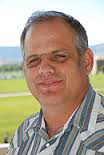Eye on Extension: Stretching hay supplies

VALLEY — For many ranchers the hay production this summer was much lower than normal years. For some it was up to 70 percent less than normal. With only 30-40 percent of a normal hay crop, many ranchers are looking for ways to stretch the hay supply.
In the San Luis Valley hay may be fed from now until May. Many ranchers have some pasture that may help them get through until sometime in November or December. After that, with the bred cows being in the third trimester of gestation, they need to improve the feed for the animals over just pasture.
The best use of any feed, whether range grass, grain or supplement, begins with an understanding of nutrient content and quality. Water quality can affect the health and performance of animals as well. Any new source of water or feed should be analyzed if health issues develop with the animals. Interpreting the results of any analysis done is a very important step. This is where the chance to reduce feed costs can begin while making sure the animals have adequate nutrition in the feed provided.
When choosing a feed laboratory, chose one that routinely analyzes the type of feed you are submitting. Most labs are certified by the National Forage Testing Association. This helps insure that the results of a forage test will be very similar whichever lab is used.
Forage analysis should include a visual appraisal as well. If there is something causing an off color, musty or moldy smell or the presence of weeds, a laboratory likely won’t identify it. It could still test as a good feed even with other issues making it a suspect feed.
A good feed analysis begins with the sample taken. The best sample is a sample that evaluates about 10 percent of the bales within the haystack. Each field will be tested separately. Even with the same feed, fields were cut and baled a day or more apart. They also had some different water or fertilizer application during the growing season. Slightly different techniques will be used to sample different feeds. Hay samples should be taken with a tube or hollow tube that can take a core sample from each bale. A handful or “slice” of hay will not give an adequate analysis in severe times. Hay probes can be bought or borrowed. The San Luis Valley Area Extension Office has a hay probe that can be borrowed to take core samples.
Hays being sampled with a hay probe can include any dried, baled hay, such as alfalfa, oat hay, Sudan, wheat hay or straw to name a few. Each hay sample should be put in a quart size zip lock baggie and identified as to the field or haystack it came from. Also, as to the type of hay it is.
Hay tests should include a forage test that includes, dry matter, crude protein, TDN, Net energy and calcium and phosphorus as the minimum test. Most forage tests will include some other information that can be used to balance a ration for your animals. Some hays should have additional testing to insure there is no toxicity in the hay.
Sudan or sorghum hays are prone to high nitrates in the feed. Growth conditions, harvest technique and timing and weather can impact nitrates in feeds. Some oat hay varieties may have high nitrates as well. Short Sudan or sorghum hay, that is less than 18 inches tall when cut will likely have prussic acid in it. It is much cheaper to test for a toxic compound in the hay than to take a chance and kill an animal, or several, before finding out there is a problem.
Once you have a feed analysis in hand, then you can determine how much higher quality feed you need and now much low-quality feed you can supplement your animals with. As an example, if you have high quality alfalfa hay, you may be able to feed 50 percent alfalfa and 50 percent straw as a ration. Or, it may be necessary to add additional supplements to complete a full ration. If you don’t have alfalfa as a base for a ration, that’s fine, the hay you do have can be tested and a base established with your hay. Remember, the results from last years hay analysis won’t be the same as this year. Growing conditions will change each year.
If you want help evaluating a feed analysis or to discuss a ration option you are considering, give the San Luis Valley Extension Office a call. If you want to borrow a hay probe to take samples with or thoughts on which feed lab to use you can also call the Extension Office at 719-852-7381.
Check out our website at http://sanluisvalley.colostate.edu
Extension programs are available to all without discrimination, Colorado State University Extension, U.S. Department of Agriculture and Colorado counties cooperating.



